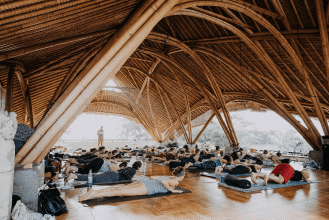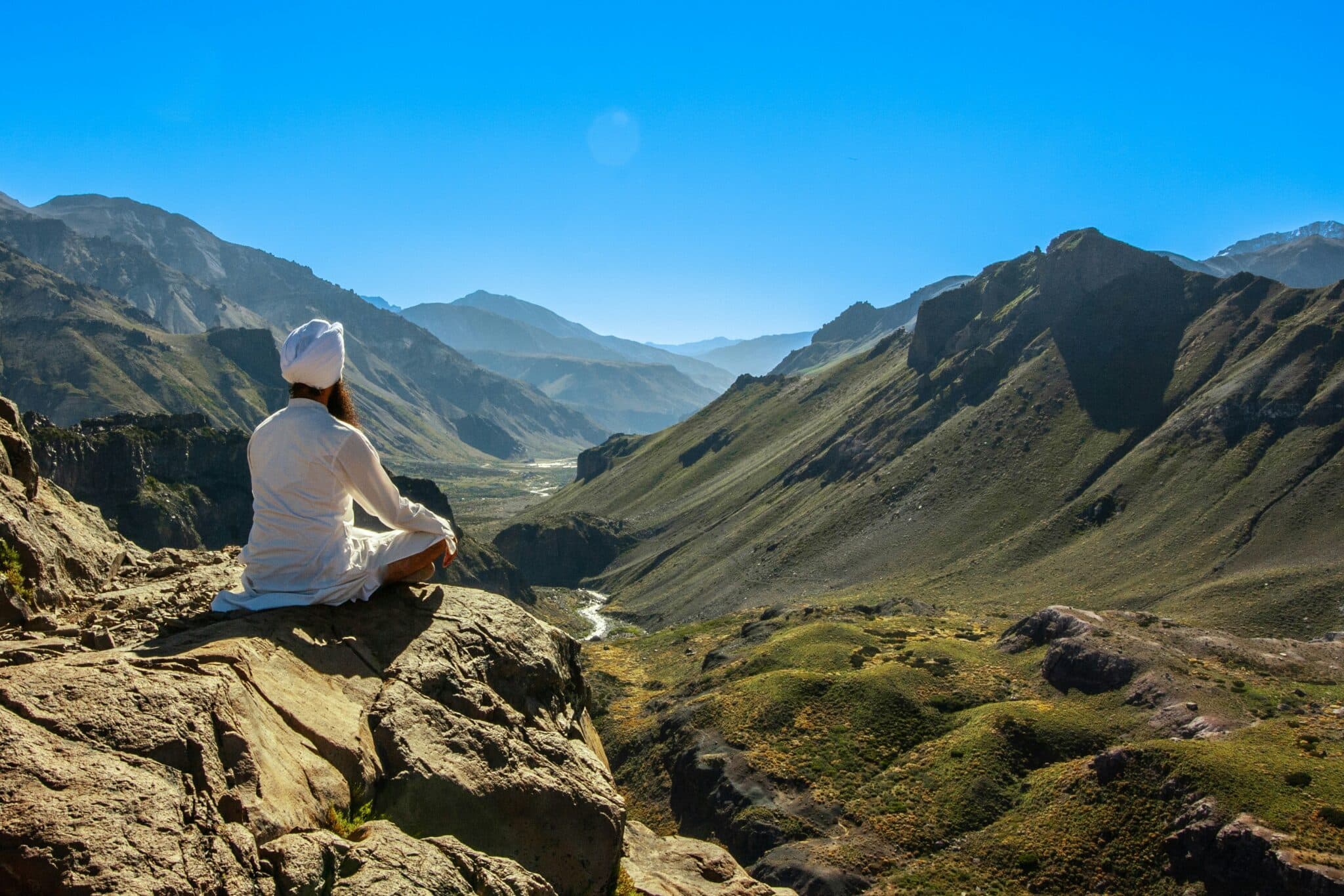
Outdoor yoga is gaining serious momentum among both students and teachers for one good reason. Research shows that practicing yoga outside can reduce stress and improve mood more effectively than indoor sessions. Now for the surprise. The uneven terrain, sounds of nature, and open sunlight combine to work your body and mind in ways you never get from a studio. So instead of just changing the scenery, outdoor yoga actually transforms the entire experience—and might just make you rethink what true wellness looks like.
Table of Contents
- How Nature Amplifies Yoga Practice
- Physical And Mental Health Benefits Outdoors
- Creating Unique Experiences For Students
- Tips For Teaching And Practicing Outside
Quick Summary
| Takeaway | Explanation |
|---|---|
| Practice outdoors for enhanced emotional well-being. | Nature boosts mood and reduces stress more effectively compared to indoor yoga sessions. |
| Engage core and stabilizing muscles on varied terrain. | Practicing on uneven surfaces improves balance, proprioception, and promotes dynamic movements not replicated indoors. |
| Foster ecological consciousness through yoga. | Outdoor practice cultivates an appreciation for the environment and inspires sustainable lifestyle choices among practitioners. |
| Create immersive experiences for students outdoors. | Utilizing diverse natural settings allows teachers to engage students in meaningful, personalized learning experiences. |
| Adapt teaching strategies for outdoor environments. | Successful outdoor yoga requires dynamic approaches, including real-time adaptations to ensure safety and enhance the practice experience. |
How Nature Amplifies Yoga Practice
Outdoor yoga transcends traditional studio practice by creating a profound connection between physical movement and natural environments. The transformative power of practicing yoga outdoors goes far beyond simple location change, offering practitioners a holistic experience that integrates mind, body, and surrounding ecosystem.
The Psychological Landscape of Natural Yoga Practice
Nature provides an extraordinary backdrop for yoga that fundamentally enhances psychological well-being. Research published in the International Journal of Environmental Research and Public Health demonstrates that outdoor physical activities, including yoga, significantly improve mood and reduce stress more effectively than indoor exercises. The sensory immersion of practicing among trees, near water, or on open ground activates deeper relaxation responses within practitioners.
The natural environment stimulates multiple sensory channels simultaneously. Practitioners experience ambient sounds like rustling leaves, distant bird calls, and gentle wind movements that create a meditative soundscape. Sunlight exposure helps regulate circadian rhythms, while fresh air increases oxygen intake, supporting more profound breathing techniques fundamental to yoga practice.
Biomechanical and Energetic Amplification
Uneven natural terrain challenges yoga practitioners in unique ways, engaging stabilizer muscles and promoting more dynamic, adaptive movement patterns. Practicing on grass, sand, or slightly uneven ground requires heightened proprioception and core engagement. This natural variability prevents movement stagnation and encourages continuous micro-adjustments that traditional flat studio floors cannot replicate.
Energetic alignment becomes more intuitive outdoors. The open space allows practitioners to feel more connected to surrounding elements, enhancing their sense of grounding and expansiveness. Many yoga practitioners report experiencing a more authentic connection to their practice when surrounded by natural landscapes, feeling less confined and more spiritually attuned.
Here’s a summary table comparing key differences and unique effects of indoor versus outdoor yoga practice, as discussed in the article. This comparison highlights specific advantages and features of practicing yoga in natural settings compared to traditional studios.
| Aspect | Indoor Yoga | Outdoor Yoga |
|---|---|---|
| Mood & Stress Reduction | Effective | More effective due to nature immersion |
| Terrain | Flat, predictable | Uneven, dynamic (grass, sand, etc.) |
| Muscle Engagement | Standard | Greater stabilizer & core activation |
| Sensory Stimulation | Limited | Multisensory (sounds, light, air, etc.) |
| Connection to Environment | Minimal | Strong (ecological awareness fostered) |

Holistic Health and Environmental Synchronization
Beyond individual benefits, outdoor yoga represents a profound ecological engagement. Practitioners develop a deeper appreciation for environmental interconnectedness, recognizing their place within broader natural systems. This perspective shift can inspire more sustainable lifestyle choices and increased environmental consciousness.
The practice becomes a form of moving meditation that simultaneously nurtures personal wellness and ecological awareness. By choosing outdoor spaces for yoga, practitioners participate in a reciprocal relationship with their environment, experiencing physical movement as a form of ecological dialogue.
Learn more about deepening your yoga practice through spiritual connection, where the boundaries between personal practice and universal awareness begin to dissolve.
Physical and Mental Health Benefits Outdoors
Outdoor yoga emerges as a powerful modality for holistic wellness, offering profound physical and mental health advantages that extend far beyond traditional studio practice. The combination of natural environments and intentional movement creates a therapeutic landscape for comprehensive healing and personal transformation.
Stress Reduction and Emotional Regulation
Research from the National Center for Complementary and Integrative Health highlights yoga’s remarkable capacity to improve general wellness by alleviating stress and supporting emotional equilibrium. When practiced outdoors, these benefits are exponentially amplified. Natural settings provide sensory stimulation that actively reduces cortisol levels, promoting a deep sense of calm and emotional resilience.
Harvard Health indicates that regular yoga practice can significantly improve mood, reduce symptoms of anxiety and depression, and enhance cognitive functions like learning and memory. Outdoor environments contribute additional neurological benefits by stimulating multiple sensory pathways, creating a more immersive healing experience.
Physical Performance and Immune System Enhancement
Outdoor yoga practice challenges practitioners through varied terrain and natural resistance, engaging muscle groups more dynamically than indoor environments. Uneven surfaces like grass, sand, or forest floors require constant micro-adjustments, improving balance, core strength, and proprioceptive awareness. Sunlight exposure during outdoor sessions also promotes vitamin D synthesis, crucial for bone health and immune system function.
The physical demands of navigating natural landscapes during yoga practice trigger enhanced metabolic responses. Practitioners experience improved cardiovascular efficiency, increased respiratory capacity, and more comprehensive muscular engagement. These physiological adaptations contribute to overall fitness and resilience.
Holistic Wellness and Psychological Restoration
The International Journal of Yoga emphasizes yoga’s multidimensional approach to wellness, noting its capacity to improve physical, mental, intellectual, and spiritual health. Outdoor practice magnifies these benefits by creating a direct connection with natural ecosystems. Practitioners report experiencing profound psychological restoration, characterized by reduced mental fatigue, increased creativity, and a heightened sense of inner peace.
Beyond individual transformation, outdoor yoga cultivates a broader ecological awareness. By practicing in natural settings, individuals develop a more interconnected understanding of personal and environmental well-being. This holistic perspective encourages sustainable lifestyle choices and a deeper appreciation for planetary health.

Discover advanced techniques for expanding your wellness practice, where the boundaries between personal healing and universal interconnectedness dissolve.
Creating Unique Experiences for Students
Outdoor yoga instruction represents a transformative opportunity for teachers to design extraordinary learning experiences that transcend traditional studio boundaries. By strategically leveraging natural environments, yoga instructors can craft immersive educational journeys that engage students on multisensory and deeply personal levels.
Designing Contextual Learning Environments
Research published in the International Journal of Environmental Research and Public Health demonstrates that outdoor physical activities provide unique sensory stimulation and psychological benefits. Yoga teachers can capitalize on this insight by intentionally selecting diverse natural settings that challenge and inspire students. Each landscape offers distinct learning opportunities mountain terrains demand greater balance and core engagement, while beach environments introduce sand resistance and dynamic ground surfaces.
Successful outdoor yoga instruction requires careful site selection and preparation. Teachers must assess terrain safety, understand environmental conditions, and develop adaptive teaching strategies that accommodate varying student skill levels. This approach transforms yoga practice from a standardized routine into a personalized, context-driven exploration.
Pedagogical Innovation and Experiential Learning
Outdoor yoga instruction allows teachers to break free from rigid curricular frameworks and embrace more intuitive, experience-based learning models. By integrating natural elements into practice sequences, instructors can create powerful metaphorical connections between physical movement and broader life principles. Wind becomes a teacher of breath control, uneven ground demonstrates adaptability, and changing light conditions illustrate impermanence.
Instructors can design progressive learning experiences that incorporate environmental interactions. For instance, a mountain yoga session might focus on strength and grounding postures, while a forest practice could emphasize flexibility and flow. These nuanced approaches encourage students to develop a more holistic understanding of yoga as a comprehensive life philosophy rather than merely a physical discipline.
Building Community and Ecological Consciousness
Outdoor yoga instruction offers unprecedented opportunities for community building and environmental awareness. Group practices in natural settings foster deeper interpersonal connections, creating shared experiences that extend beyond individual practice. Students learn collaborative skills, develop mutual support networks, and cultivate a sense of collective consciousness.
Moreover, practicing yoga in natural environments inherently promotes ecological mindfulness. Students begin to perceive themselves as integral parts of broader ecosystems, developing respect and appreciation for environmental interconnectedness. This perspective shift can inspire more sustainable lifestyle choices and a more profound understanding of personal and planetary wellness.
Explore our advanced teaching methodologies for transformative yoga instruction, where educational innovation meets holistic personal development.
Tips for Teaching and Practicing Outside
Transitioning yoga practice and instruction into outdoor environments requires strategic preparation, thoughtful adaptation, and a nuanced understanding of natural settings. Successful outdoor yoga experiences demand more than simply relocating a traditional studio practice they require a holistic approach that respects both practitioner needs and environmental dynamics.
Preparation and Environmental Awareness
BlueCross BlueShield of Vermont emphasizes the critical importance of comprehensive preparation for outdoor yoga practice. Teachers and practitioners must anticipate potential environmental challenges by packing essential items like sunscreen, insect repellent, hydration supplies, and adaptable clothing layers. Selecting an appropriate location involves careful assessment of terrain safety, ground stability, and potential environmental distractions.
Weather considerations play a significant role in outdoor yoga planning. Understanding local climate patterns, potential temperature fluctuations, and potential precipitation risks allows practitioners to design more resilient practice strategies. Lightweight, moisture-wicking clothing and portable yoga mats or natural ground coverings become essential tools for maintaining comfort and practice continuity.
The following table summarizes essential preparation steps and environmental considerations for successful outdoor yoga sessions, based on points mentioned in the article. Use this as a checklist to enhance safety and comfort.
| Preparation Step | Description |
|---|---|
| Location Assessment | Ensure terrain is safe and stable |
| Weather Awareness | Research local climate and forecast |
| Sun Protection | Bring sunscreen and/or wear protective clothing |
| Insect Prevention | Pack insect repellent as needed |
| Hydration | Carry sufficient water or electrolyte drinks |
| Adaptive Clothing | Dress in layers and choose moisture-wicking fabrics |
| Essential Gear | Use portable mats or ground coverings for comfort |
Adaptive Teaching and Practice Techniques
Outdoor yoga instruction requires a more dynamic and flexible pedagogical approach. The Natural Learning Initiative suggests incorporating environmental elements directly into practice sequences, transforming natural surroundings into interactive learning resources. Teachers can design pose variations that leverage natural terrain features like boulders, tree stumps, or gentle slopes to challenge balance, enhance proprioception, and create more engaging practice experiences.
Instructors should develop heightened observational skills to monitor student safety and adapt instructions in real-time. Uneven ground, potential wildlife interactions, and changing light conditions demand constant attentiveness. Modifying traditional pose alignments to accommodate natural surfaces becomes crucial, emphasizing fluid adaptability over rigid technical precision.
Building Community and Fostering Connection
West Virginia University Extension highlights the importance of creating inclusive, supportive outdoor yoga experiences. Group practices in natural settings offer unique opportunities to develop collective awareness and interpersonal connections. Teachers can design collaborative sequences that encourage mutual support, shared exploration, and a sense of collective mindfulness.
Beyond physical practice, outdoor yoga becomes a platform for ecological education and environmental appreciation. Instructors can integrate mindful observations of natural surroundings, encouraging students to develop deeper connections with their immediate ecosystem. This approach transforms yoga from a personal physical practice into a broader exploration of human-environment relationships.
Discover advanced techniques for creating transformative yoga experiences, where teaching transcends traditional boundaries and embraces holistic learning approaches.
Frequently Asked Questions
What are the benefits of practicing yoga outdoors?
Practicing yoga outdoors enhances emotional well-being, boosts mood, reduces stress more effectively than indoor sessions, and engages core and stabilizing muscles due to uneven terrains.
How does outdoor yoga impact my physical performance?
Outdoor yoga increases physical performance by requiring adaptations to varied terrains, which engages more muscle groups, improves balance, proprioception, and enhances cardiovascular efficiency and immune system function.
What should I consider when preparing for an outdoor yoga session?
When preparing for outdoor yoga, consider the safety of the terrain, weather conditions, sun protection, hydration, insect prevention, and wear adaptive clothing suitable for changing environmental factors.
How can yoga instructors create unique experiences for students outdoors?
Instructors can create unique experiences by designing personalized lessons that leverage natural settings, integrate environmental elements into practice, and foster a sense of community among participants through collaborative sequences.
Ready to Take Your Outdoor Yoga Experience to the Next Level?
Making the shift to practicing or teaching yoga outdoors brings incredible benefits—greater emotional well-being, stronger core stability, and a deeper sense of connection with nature. As highlighted in our article, many teachers and practitioners face challenges like designing immersive sessions, adapting to changing environments, and seeking holistic growth that goes beyond traditional indoor studios. If you are searching for expert guidance, transformative learning environments, and ways to deepen both your practice and teaching methodology, your next step is clear.

Join a community of passionate yogis and elevate your skill set through Yoga East West’s accredited teacher training programs. Our luxury location courses in Bali, Costa Rica, and Thailand immerse you in nature while delivering world-class instruction in yoga philosophy, anatomy, meditation, and more. Visit our main site today and take the first step toward mastering the art of outdoor and holistic yoga teaching before our next training cohort fills up.
















